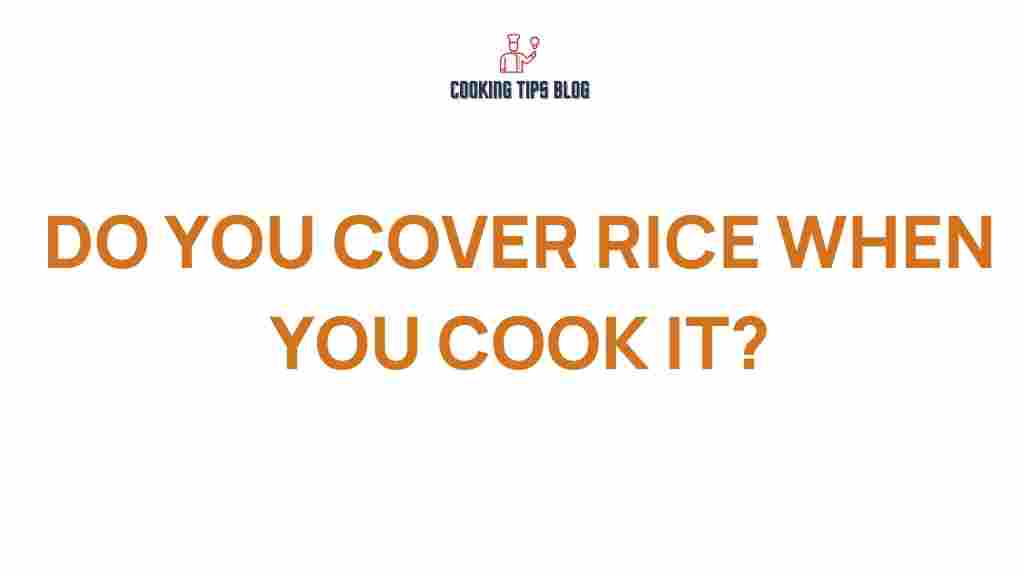The Surprising Secrets: Do You Need to Cover Rice While Cooking?
When it comes to rice cooking, many home chefs often find themselves wondering about the best practices to achieve that perfect fluffy texture. One common question that arises is whether or not to cover the pot while cooking rice. This seemingly simple decision can significantly affect the outcome of your dish. In this article, we will delve into the surprising secrets of rice cooking, exploring the benefits and drawbacks of covering rice while it cooks, along with some expert tips for perfecting your rice dishes.
Understanding Rice Cooking Basics
Before diving into whether you should cover your rice while it cooks, it’s essential to understand the basic principles of rice cooking. Rice is a staple food for many cultures around the world, and its cooking method can vary based on the type of rice you use. Here are some key points to consider:
- Types of Rice: Different types of rice, such as long-grain, short-grain, and brown rice, have unique cooking properties.
- Water Ratio: The amount of water needed varies based on the type of rice and the cooking method.
- Cooking Time: Each rice type requires a different cooking time for optimal texture.
Should You Cover Rice While Cooking?
The decision to cover rice while cooking can influence moisture retention, cooking time, and overall texture. Here’s a breakdown of the advantages and disadvantages:
Advantages of Covering Rice
- Moisture Retention: Covering the pot traps steam, which helps cook the rice evenly and prevents it from drying out.
- Faster Cooking: A covered pot tends to cook rice faster due to the build-up of steam and heat.
- Reduced Risk of Overflow: Covering the pot can help reduce the risk of boiling over, especially when cooking starchy rice.
Disadvantages of Covering Rice
- Overcooking: If left covered for too long, rice can become mushy as it absorbs excess moisture.
- Steam Release: In certain recipes, releasing steam can be beneficial for achieving a specific texture.
Step-by-Step Guide to Cooking Rice
Now that we’ve established the pros and cons of covering rice while cooking, let’s explore a step-by-step guide to cooking rice perfectly, whether you choose to cover it or not:
Step 1: Measure Your Rice
Start by measuring out the quantity of rice you plan to cook. A standard serving is about 1/2 cup of uncooked rice per person.
Step 2: Rinse the Rice (Optional)
Rinsing rice can remove excess starch and improve the final texture. If you’re using a high-starch variety, consider rinsing it under cold water until the water runs clear.
Step 3: Measure Water
The water-to-rice ratio varies. A common ratio for white rice is 2 cups of water for every 1 cup of rice, while brown rice typically requires 2.5 cups of water per cup of rice.
Step 4: Combine Rice and Water
In a pot, combine your rinsed rice and measured water. Add a pinch of salt if desired.
Step 5: Bring to a Boil
Bring the mixture to a rolling boil over medium-high heat. Once boiling, reduce heat to low.
Step 6: Cover and Simmer
At this stage, cover the pot with a lid. Allow the rice to simmer for the recommended time:
- White rice: 15–20 minutes
- Brown rice: 40–50 minutes
Step 7: Let it Rest
After the cooking time is up, turn off the heat but leave the lid on for an additional 5–10 minutes. This resting period allows the rice to finish cooking in its steam.
Step 8: Fluff and Serve
Finally, remove the lid and fluff the rice gently with a fork before serving. Enjoy your perfectly cooked rice!
Troubleshooting Common Rice Cooking Issues
Even with the best techniques, cooking rice can sometimes go awry. Here are some common issues and how to resolve them:
Rice is Too Sticky
If your rice turns out too sticky, it may be due to excess starch. Rinse the rice before cooking to remove some of that starch. Also, ensure you’re using the correct water-to-rice ratio.
Rice is Undercooked
If your rice is crunchy or hard, it likely needs more cooking time or water. Add a small amount of boiling water and cover the pot again, cooking for an additional 5-10 minutes.
Rice is Overcooked
Overcooked rice can become mushy. To avoid this, monitor the cooking time and remove the pot from heat as soon as the rice absorbs the water.
Burnt Rice
Burnt rice typically occurs if the heat is too high. Always start with medium heat, and once boiling, reduce the heat to low to simmer.
Conclusion
In conclusion, the question of whether to cover rice while cooking has no one-size-fits-all answer. While covering the pot can help retain moisture and speed up the cooking process, it can also lead to overcooked rice if not monitored carefully. Understanding the type of rice you are cooking and following the proper techniques will ensure you achieve the perfect texture every time.
Next time you find yourself in the kitchen, consider your rice cooking methods thoughtfully. Whether you choose to cover your pot or not, practice makes perfect, and with these tips, you’ll be well on your way to mastering the art of rice cooking.
For more cooking tips and techniques, check out our comprehensive cooking guide. If you’d like to explore the science behind cooking rice in detail, visit this informative resource.
This article is in the category Basic and created by Cookingtipsblog Team
